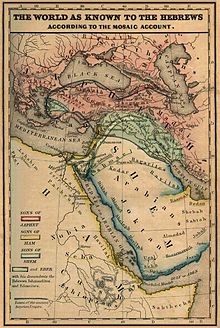
Japheth is one of the three sons of Noah in the Book of Genesis, in which he plays a role in the story of Noah's drunkenness and the curse of Ham, and subsequently in the Table of Nations as the ancestor of the peoples of the Aegean Sea, Anatolia, Caucasus, Greece, and elsewhere in Eurasia. In medieval and early modern European tradition he was considered to be the progenitor of the European peoples.
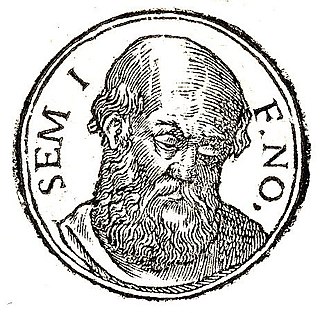
Shem was one of the sons of Noah in the Bible.
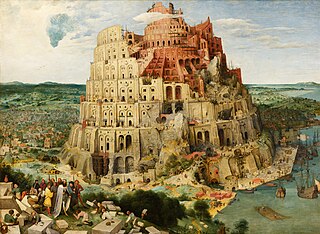
The Tower of Babel is an origin myth and parable in the Book of Genesis meant to explain the existence of different languages and cultures.
Elam in the Hebrew Bible is said to be one of the sons of Shem, the son of Noah. The name is also used for the ancient country of Elam in what is now southern Iran, whose people the Hebrews believed to be the offspring of Elam, son of Shem. This implies that the Elamites were considered Semites by the Hebrews. Their language was not one of the Semitic languages, but is considered a linguistic isolate.
Tarshish occurs in the Hebrew Bible with several uncertain meanings, most frequently as a place far across the sea from Phoenicia and the Land of Israel. Tarshish was said to have exported vast quantities of important metals to Phoenicia and Israel. The same place name occurs in the Akkadian inscriptions of Assyrian king Esarhaddon and also on the Phoenician inscription of the Nora Stone in Sardinia; its precise location was never commonly known, and was eventually lost in antiquity. Legends grew up around it over time so that its identity has been the subject of scholarly research and commentary for more than two thousand years.

The Generations of Noah, also called the Table of Nations or Origines Gentium, is a genealogy of the sons of Noah, according to the Hebrew Bible, and their dispersion into many lands after the Flood, focusing on the major known societies. The term 'nations' to describe the descendants is a standard English translation of the Hebrew word "goyim", following the c. 400 CE Latin Vulgate's "nationes", and does not have the same political connotations that the word entails today.
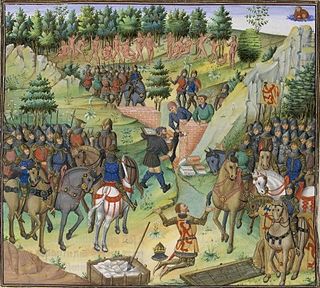
Gog and Magog or Ya'juj and Ma'juj are a pair of names that appear in the Bible and the Qur'an, variously ascribed to individuals, tribes, or lands. In Ezekiel 38, Gog is an individual and Magog is his land. By the time of the New Testament's Revelation 20, Jewish tradition had long since changed Ezekiel's "Gog from Magog" into "Gog and Magog".
Tubal, in Genesis 10, was the name of a son of Japheth, son of Noah. Modern scholarship has identified him with Tabal. Traditionally, he is considered to be the father of the Caucasian Iberians according to primary sources. Later, Saint Jerome refashioned the Caucasian Iberia (Georgia) into the Iberian Peninsula and Isidore of Seville consolidated this idea.

Peleg is mentioned in the Hebrew Bible as one of the two sons of Eber, an ancestor of the Ishmaelites and the Israelites, according to the Generations of Noah in Genesis 10–11 and 1 Chronicles 1.

Keturah was a wife and a concubine of the Biblical patriarch Abraham. According to the Book of Genesis, Abraham married Keturah after the death of his first wife, Sarah. Abraham and Keturah had six sons. According to Jewish tradition, she was a descendant of Noah's son Japheth.

Magog is the second of the seven sons of Japheth mentioned in the Table of Nations in Genesis 10.

The Mushki were an Iron Age people of Anatolia who appear in sources from Assyria but not from the Hittites. Several authors have connected them with the Moschoi (Μόσχοι) of Greek sources and the Georgian tribe of the Meskhi. Josephus Flavius identified the Moschoi with the Biblical Meshech. Two different groups are called Muški in Assyrian sources, one from the 12th to the 9th centuries BC near the confluence of the Arsanias and the Euphrates and the other from the 8th to the 7th centuries BC in Cappadocia and Cilicia. Assyrian sources clearly identify the Western Mushki with the Phrygians, but later Greek sources then distinguish between the Phrygians and the Moschoi.
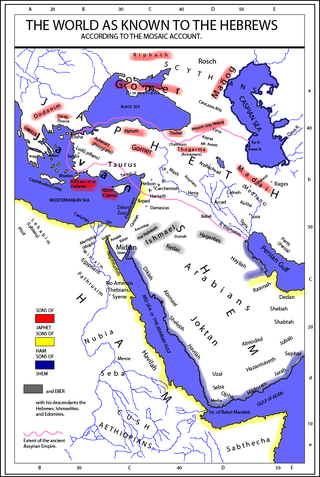
Togarmah is a figure in the "table of nations" in Genesis 10, the list of descendants of Noah that represents the peoples known to the ancient Hebrews. Togarmah is among the descendants of Japheth and is thought to represent some people located in Anatolia. Medieval sources claimed that Togarmah was the legendary ancestor of several peoples of the Caucasus.
Tiras is, according to the Book of Genesis and 1 Chronicles, the seventh and youngest son of Japheth in the Hebrew Bible. A brother of biblical Javan, its geographical locale is sometimes associated by scholars with the Tershi or Tirsa, one of the groups which made up the Sea Peoples "thyrsenes" (Tyrrhenians), a naval confederacy which terrorized Egypt and other Mediterranean nations around 1200 BCE. These Sea People are referred to as "Tursha" in an inscription of Ramesses III, and as "Teresh of the Sea" on the Merneptah Stele.

Kittim was a settlement in present-day Larnaca on the east coast of Cyprus, known in ancient times as Kition, or Citium. On this basis, the whole island became known as "Kittim" in Hebrew, including the Hebrew Bible. However the name seems to have been employed with some flexibility in Hebrew literature. It was often applied to all the Aegean islands and even to "the W[est] in general, but esp[ecially] the seafaring W[est]". Flavius Josephus records in his Antiquities of the Jews that
Gomer was the eldest son of Japheth, and father of Ashkenaz, Riphath, and Togarmah, according to the "Table of Nations" in the Hebrew Bible.

The term Japhetites refers to the descendants of Japheth, one of the three sons of Noah in the Book of Genesis. The term was used in ethnological and linguistic writings from the 18th to the 20th centuries as a Biblically derived racial classification for the European peoples, but is now considered obsolete. Medieval ethnographers believed that the world had been divided into three large-scale groupings, corresponding to the three classical continents: the Semitic peoples of Asia, the Hamitic peoples of Africa, and the Japhetic peoples of Europe.
Riphath was great-grandson of Noah, grandson of Japheth, son of Gomer, younger brother of Ashkenaz, and older brother of Togarmah according to the Table of Nations in the Hebrew Bible. The name appears in some copies of 1 Chronicles as "Diphath", due to the similarities of the characters resh and dalet in the Hebrew and Aramaic alphabets.
Aram is a son of Shem, according to the Table of Nations in Genesis 10 of the Hebrew Bible, and the father of Uz, Hul, Gether and Mash or Meshech. The Book of Chronicles lists Aram, Uz, Hul, Gether, and Meshech as descendants of Shem, although without stating explicitly that Aram is the father of the other four.

Since early modern times, a number of biblical ethnonyms from the Table of Nations in Genesis 10 have been used as a basis for classifying human racial and national identities. The connection between Genesis 10 and contemporary ethnic groups began during classical antiquity, when authors such as Josephus, Hippolytus and Jerome analyzed the biblical list.
